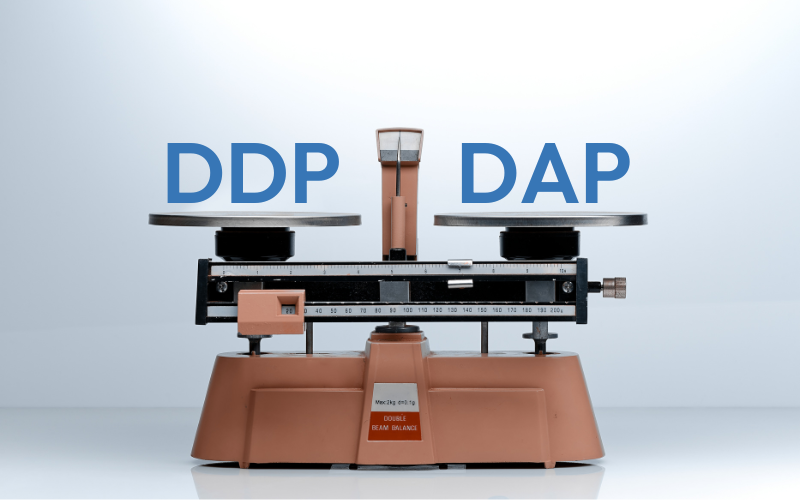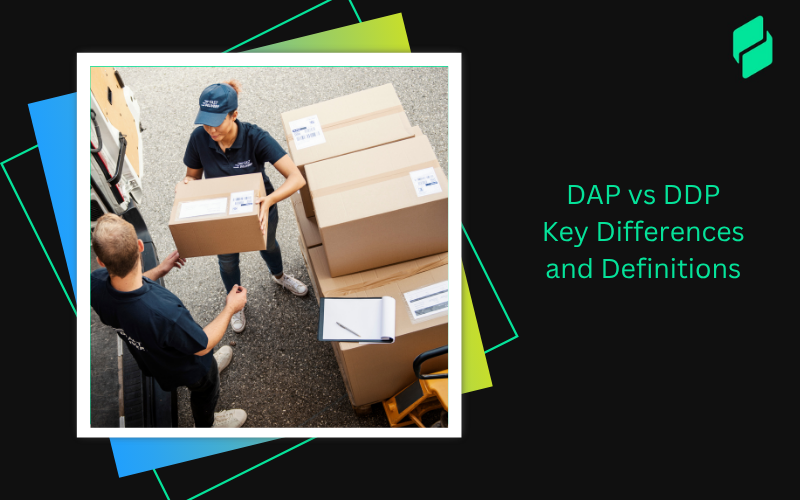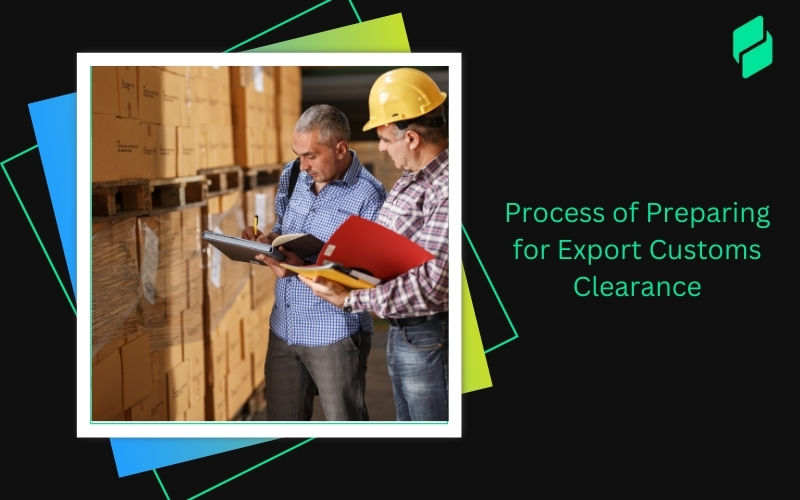Optimize your business: use unlimited savings with Pazago fulfilled now!
Get Started ->If you're handling international shipments, knowing the difference between DAP and DDP is essential. These Incoterms define who is responsible for delivery, customs clearance, and payment of duties.
They may seem similar, but choosing the wrong one can lead to delays, extra costs, or legal confusion.
India’s exports reached ₹5.20 trillion (about USD 65.5 billion) in June 2024, showing a 5.4 percent year-on-year growth. If you're part of this growing trade activity, understanding these terms is key to avoiding unnecessary issues and staying competitive.
In this blog, you’ll get a clear explanation of both DAP and DDP, how they work in practise, and how to decide which term fits your next shipment.
TL;DR
- DAP (Delivered Duty Paid) means the seller delivers goods to your location, but you handle import duties, taxes, and customs clearance.
- DDP (Delivered Duty Paid) means the seller manages delivery and customs clearance and pays all duties and taxes upfront.
- With DAP, risk transfers to you when goods are ready for unloading; with DDP, risk transfers at delivery, ready for unloading.
- DAP offers you more control over import processes, while DDP simplifies shipping by shifting responsibility to the seller.
- Choosing between DAP and DDP depends on your experience with customs, cost management, and how much control you want.
What Are Incoterms?
Incoterms are a set of international rules that define the responsibilities of buyers and sellers in the shipment of goods.
They clarify who is responsible for costs, risks, and tasks like transportation, customs clearance, and delivery at each stage of the shipping process.
Using Incoterms helps you avoid confusion by clearly outlining when ownership and risk transfer from the seller to you.
These rules apply worldwide and are updated regularly to reflect current trade practises. Understanding Incoterms ensures smoother transactions and better planning in your import-export activities.
Also Read: Differences between CIP and CIF Incoterms
Next, we’ll take a closer look at Delivered Duty Paid (DDP) and what it means for your shipments.
What is DDP?

DDP stands for Delivered Duty Paid. Under this term, the seller takes full responsibility for delivering the goods directly to your chosen location.
This includes handling export procedures, shipping, import customs clearance, and paying all applicable duties and taxes.
You do not have to deal with any customs formalities or unexpected charges. Everything is included in the purchase price, so you receive the goods ready for unloading.
Key points under DDP:
- The seller handles both export and import formalities.
- All transportation, customs duties, and taxes are included in the price.
- Delivery takes place at your named place, ready for unloading.
- Your role begins only once the goods arrive at your location
Moving on, here’s what you need to know about Delivered At Place (DAP) and how it differs from DDP.
What is DAP?

DAP stands for Delivered At Place. With this Incoterm, the seller is responsible for delivering the goods to a location you specify.
The seller handles export formalities, shipping, and transportation to your destination.
You are responsible for import customs clearance, paying any duties or taxes, and unloading the goods once they arrive. This means you will need to manage the import paperwork and costs.
Key points under DAP:
- The seller handles export procedures and transportation to your location.
- You are responsible for import customs clearance and paying duties and taxes.
- You handle unloading the goods at the destination.
- Your responsibility starts when the goods arrive at the agreed place
Also Read: Understanding DAP Incoterms and Delivered at Place Details
To help you make an informed choice, next, you will understand how DDP and DAP differ in practise.
DAP vs DDP: What Are the Key Differences?
When you import or export goods, understanding the terms that define your responsibilities is important.
Two commonly used Incoterms you will encounter are Delivered Duty Paid (DDP) and Delivered At Place (DAP).
Both outline how shipping costs, customs clearance, and taxes are handled, but they differ in who takes on these duties.
Choosing between DDP and DAP affects how much control and responsibility you have over the shipment process.
With DDP, the seller manages everything, including import duties and taxes, making delivery simpler for you.
With DAP, you handle import customs and related costs, giving you more involvement in the final stages of the shipment. Knowing these differences helps you pick the option that works best for your business needs.
Comparing DAP and DDP Responsibilities
Here's a quick comparison of DAP vs DDP for your understanding:
Also Read: Differences Between FOB and FCA in Shipping Terms
In the next section, look at what you should think about before deciding which Incoterms fits your business best.
Considerations for Choosing Between DDP and DAP
When deciding between DDP and DAP, you should evaluate several factors to find the best fit for your business needs:
- Control Over Customs Clearance
With DAP, you manage import duties, taxes, and customs procedures, giving you direct control. With DDP, the seller handles all customs formalities, reducing your involvement. - Financial Planning and Cost Predictability
DDP offers predictable costs since all fees are included in the seller’s price. DAP requires you to budget for import-related expenses separately, which may vary. - Experience with Import Regulations
If you are familiar with local customs rules and have trusted brokers, DAP lets you use that knowledge. If not, DDP simplifies the process by shifting responsibility to the seller. - Risk and Responsibility
DDP places the maximum responsibility on the seller, while with DAP, you take on the import risks once the goods reach your country. - Speed of Delivery
DDP may speed up delivery since the seller manages customs clearance. DAP may involve delays if you are not prepared for timely clearance. - Cost Management
You might save money with DAP by negotiating taxes or fees locally. DDP is generally more convenient but might come at a premium for the added service.
Consider these points carefully to decide which Incoterm aligns best with your trade practises and business capabilities.
Make managing shipments easier with Pazago’s real-time tracking and organised document management. Stay on top of your deliveries and avoid costly delays.
Still unsure which to pick? The next section helps you match the right term to your specific needs.
DDP vs. DAP: Which Should You Use?

Choosing between DDP and DAP depends on how much responsibility and control you want over your shipments and import processes. Consider the following points carefully:
When DDP is the right choice for you:
- The seller takes full responsibility for all shipping costs, including export and import duties, taxes, and customs clearance.
- You receive your goods at the agreed destination with all fees paid upfront, simplifying your financial planning.
- You avoid managing customs paperwork and payments, reducing delays caused by customs clearance on your side.
- It works well if you want a seamless delivery experience without dealing with complex import regulations.
- This option suits businesses that prefer predictable shipping costs and minimal involvement in logistics.
When DAP is better suited for your needs:
- The seller covers transport and export costs, but you handle import duties, taxes, and customs clearance at the destination.
- You have control over the import process, which allows you to work with local customs agents or brokers directly.
- Managing customs clearance yourself can help you save money by optimising taxes or avoiding unnecessary fees.
- You need to be prepared to manage the documentation and payments required upon arrival of the goods.
- This option fits businesses familiar with import regulations who want to maintain control over clearance and costs.
Evaluate your business’s experience with customs procedures, your capacity to handle paperwork, and your preference for control and cost predictability. These factors will guide you to select the right Incoterms for your shipping needs.
Even the best shipping plans come with obstacles. Next, learn about what challenges you might face with DDP and DAP.
Challenges with DDP and DAP
Both DDP and DAP come with their own set of challenges that can affect how smoothly your shipments move across borders. Knowing these issues can help you prepare and manage risks better.
Challenges with DDP
- High Seller Responsibility
The seller manages customs clearance, pays import duties and taxes, and handles all import regulations. This increases complexity and costs for the seller. - Higher Costs for Sellers
Covering all import-related expenses can raise the seller’s overall costs, which may affect pricing. - Compliance Risks
Sellers must understand and comply with import laws in the buyer’s country to avoid delays, fines, or shipment seizures. - Less Control for Buyers
Buyers have limited influence over customs clearance and timing, which can be a drawback if they prefer managing local processes.
Challenges with DAP
- Buyer Bears Import Costs and Risks
Buyers are responsible for customs clearance, duties, and taxes, which require knowledge of local regulations and can impact budgeting. - Possibility of Delays
Delays can occur if buyers are not ready or slow to clear goods through customs, affecting supply schedules. - Need for Close Coordination
Effective communication between the buyer and seller is necessary to handle documentation and delivery smoothly. - Early Risk Transfer
Risk shifts to the buyer when goods are ready for unloading, which might be before they physically receive the shipment.
Understanding these challenges helps you decide which Incoterm fits your business needs and prepare for potential obstacles in your shipping process.
To avoid delays, you need to get the paperwork right. The next section walks you through the key documents and compliance steps.
Documentation and Compliance

Keeping your paperwork in order is crucial when working with DDP or DAP. Proper documentation helps avoid delays, ensures smooth customs clearance, and keeps your shipments compliant with regulations.
Key Documents to Prepare
- Commercial Invoice: Details the goods, their value, and terms of sale.
- Packing List: Describes the contents, weight, and dimensions of each package.
- Bill of Lading/Airway Bill: Confirms shipment and ownership transfer.
- Customs Declaration Forms: Required for import clearance.
- Import/Export Licenses: Needed depending on product type and destination.
- Insurance Certificates: Covering shipment risks.
Ensuring Compliance
- Verify that all documents match shipment details to prevent customs issues.
- Confirm import regulations and duties for your destination country.
- Maintain records for audits and tax purposes.
- Coordinate with freight forwarders and customs brokers for timely filings.
Following thorough documentation and compliance practises keeps your shipments moving without hold-ups and reduces the risk of penalties.
Also Read: Common Documents Required for Import and Export Procedures
How Pazago Simplifies Managing DDP and DAP Shipments
DAP vs DDP terms involve coordinating multiple tasks, from documentation to customs clearance. Pazago helps you manage these steps efficiently, reducing delays and improving accuracy.
- Smooth Communication Hub: Connect effortlessly with agents, freight forwarders, and insurers. Quick coordination helps you solve problems faster and avoid costly delays.
- Centralised Document Management: Keep all your shipping and export documents secure and easy to access in one place. This reduces errors and speeds up customs clearance.
- Live Shipment Tracking: Track your shipments in real time so you always know where your goods are. Immediate updates let you handle issues quickly, protecting your delivery schedules and profits.
- Quality Checks: Make sure your goods meet international standards before shipping. This helps prevent rejections or returns that could hurt your business.
- Cross-Border Effective Logistics Solutions: Optimise your shipping routes to lower freight costs without sacrificing reliability.
- Insurance Management: Manage your export insurance policies and claims right inside the platform, reducing risks from damage or delays.
- Complete Trade Management Portal: Oversee your export transactions from start to finish in one place, making order fulfilment simpler and faster.
Using Pazago can help you keep your shipments on schedule, stay organised, and handle the challenges of DDP and DAP shipping more confidently.
Conclusion
Choosing between DDP and DAP depends on how much control and responsibility you want over your shipments and import processes. Both terms have advantages and challenges, so understanding them helps you avoid delays, unexpected costs, and compliance issues.
Using a platform like Pazago can make managing your shipments easier. With real-time tracking, centralised documents, and smooth communication tools, you can stay on top of every step, no matter which Incoterm you use.
Get started with Pazago today by connecting with our experts!
FAQs
1. What does DAP mean in shipping?
DAP stands for Delivered At Place. The seller delivers the goods to a specified location, but the buyer handles import customs clearance, duties, taxes, and unloading.
2. What does DDP mean in shipping?
DDP means Delivered Duty Paid. The seller takes full responsibility for delivering the goods, including customs clearance, duties, and taxes, all paid upfront. The buyer only unloads the goods.
3. Who is responsible for customs clearance under DAP and DDP?
Under DAP, the buyer manages customs clearance and import duties. Under DDP, the seller handles all customs formalities and pays duties and taxes.
4. When does the risk transfer from seller to buyer in DAP and DDP?
For DAP, risk transfers when goods are ready for unloading at the agreed place. For DDP, risk transfers once the goods are delivered and ready for unloading at the buyer’s location.
5. Which Incoterm offers more control to the buyer?
DAP offers more control to the buyer since they manage import customs clearance, duties, and taxes. DDP shifts most responsibilities to the seller.
6. How can I decide whether to use DAP or DDP?
Consider your experience with import regulations, willingness to handle customs, budget predictability, and how much control you want over the shipment process.


.png)








